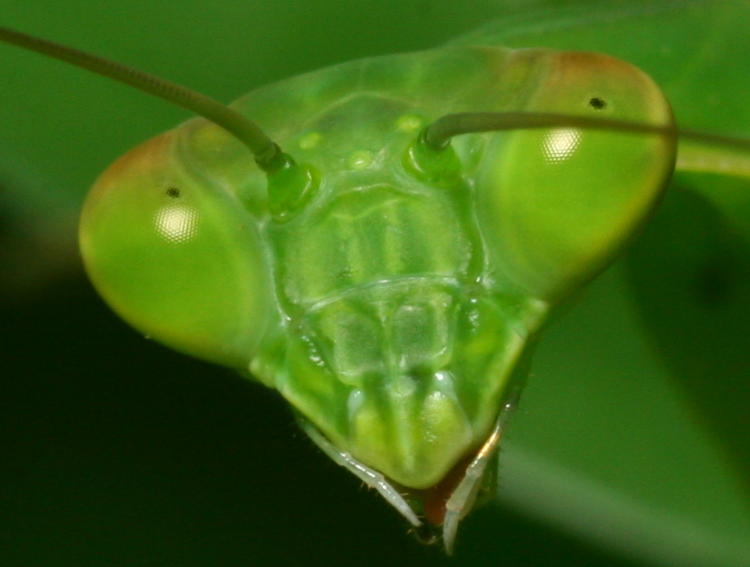
By about this time in the past few years, I would have posted roughly four thousand mantis pictures. I am definitely behind those numbers this year, so let’s see if we can rectify that.
To begin with, I was super-prepared this spring, having ordered a bunch of Chinese mantis (Tenodera sinensis) egg cases – called “oothecas” if you want to get technical or simply confuse people – and posted them in strategic locations around the yard. This was partially because I had found none left by last year’s brood, and partially to increase the odds that I could video them hatching. Somehow, this never came to pass; while one case was discovered and consumed by a squirrel, none of the rest appeared to have hatched out, though with the weird-ass indecisive spring weather, it’s possible one hatched out while we were away at Topsail. The evidence for this is lacking, though, since I found no significant clusters of little tiny mantids anywhere in the posted locations.
Despite this, there are still several specimens to be found in the region, so there was a successful egg case somewhere. And so, I have been taking the occasional opportunity to do my thang, as it were. The image at top is from a shy one found in the backyard, one that definitely wasn’t happy with close approaches, which is how I found it: it jumped away as I drew close, and I spotted the movement. With a little dodging and patience, I got in close for a portrait, and the image up there is a tight crop of it to show off the detail; it measured no more than 6mm across the eyes.
Later on, I went out at night with the misting bottle and did my arcane summoning ritual. With the dry sweltering days we’ve been having, the insects are desperate for dew to form, which generally hasn’t been happening, so when an area is blasted heavily with the misting bottle, suddenly critters appear to partake of the moisture; I have, on numerous occasions, flushed out mantises where I could see none at all.
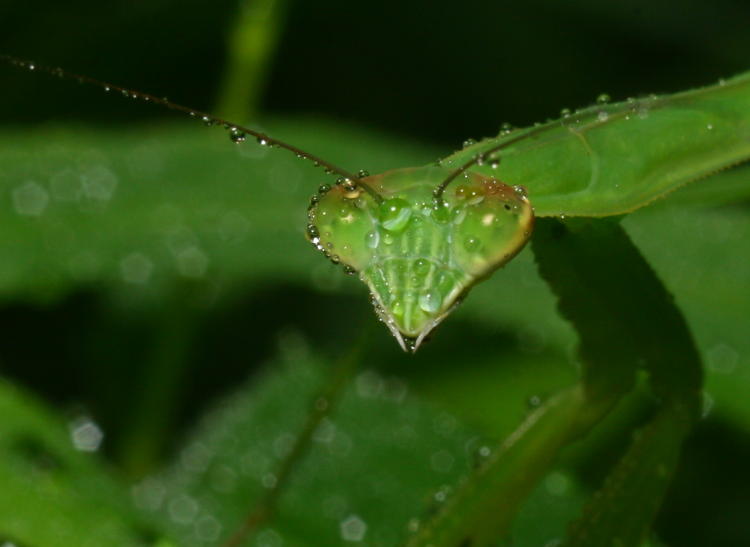
This is, quite possibly, the same one as above, since it was roughly two meters away from where I’d seen that one. At night, working with the headlamp, it can be easier to get in close because the mantises cannot always distinguish the person looming over them – plus the moisture offering keeps them occupied. I had to feature this pic since I found the rim of droplets fascinating.
And they take advantage of this, too – I mean, the adhering drops, not my fascination. They can always be seen to wipe away the drops from their eyes and then clean what they can from their forelegs, and while the distortion from portions of their vision might be significant because of the water, they never seem bothered by it; I imagine they can make out enough crucial details through the ommatidia that are not obscured. And sometimes, you can see how desperate for water they really are.

Yep, that’s its antenna in its mouth, being cleaned of all adhering water. While the mantis might want to keep its sensory organ pristine as well, I’m pretty certain this was a moisture thing.
By the way, some time before I had found a Carolina mantis (Stagmomantis carolina) and so I did not neglect that one when making it rain. This is quite a bit smaller than the Chinese mantids, roughly 20mm in length while the Chinese were running close to 70. It received a lighter misting because it seemed slightly agitated as it occurred, perhaps concerned that a heavy rainfall might be forthcoming.
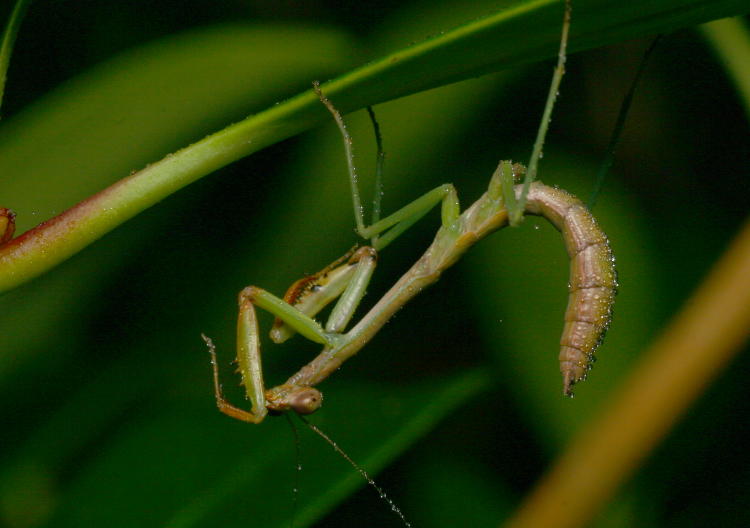
I never see very many of these around; I suspect they don’t compete well with the Chinese mantids, and in fact I have more than a passing suspicion that the Chinese mantids don’t compete well either – if the sudden jumps in size right about the same time as the reduction in the number of specimens I can spot is any correlation, they may be cannibalizing each other. Survival of the fittest and all that.
It’s not only the mantises that come up for the water. This guy appeared from under cover as I laid down a nice blanket, and I aimed some extra blasts in its direction, from which it shied away not at all.
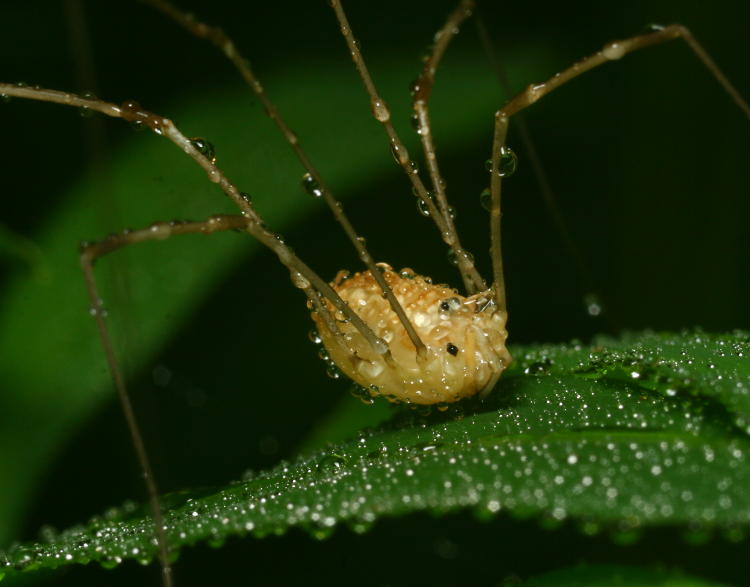
I probably don’t have to tell anyone what this is, being one of the most ubiquitous and recognizable arachnids in the US, but “daddy longlegs” isn’t a proper term in any respect. Commonly called a harvestman (regardless of gender) or more scientifically a member of the Order Opilione, which is separate and distinct from “spiders” while still arachnids. But you know what gets me? Despite the ease which they can be found, the jury is still out on whether they actively hunt like spiders, or merely scavenge already dead prey – we don’t know for sure how they eat. One of these evenings I’ll have to stake out a few and see what I see. I’ll need a lot of batteries for the headlamp.
By the way, while I was chasing the newly-emerged frogs the other night, I spotted a tiny damselfly on the lizard’s tail leaves, and was able to go in close by the light of the headlamp – the following day I tried this in sunlight and the insect wasn’t having none of that. So here’s the full frame image, Mamiya 80mm macro with extension tube:
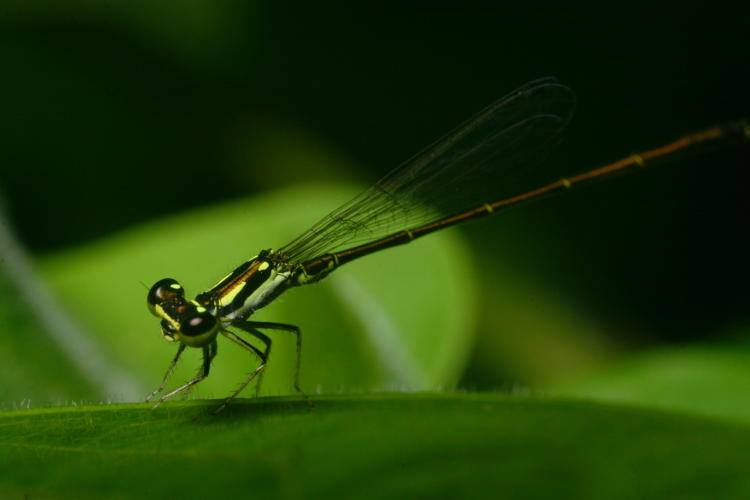
And now here’s the tighter crop of the same image, and I draw your attention to those tiny hairs on the body:

For the record, this specimen is 20mm in length or less, able to hide under a large coin, so I’ll let you calculate the width of those body hairs (and ‘hair’ is likely the wrong term but I’ll let a professional entomologist fill in the blanks, because I’m lazy tonight.) Look – there’s even some on the mouthparts, so I’m guessing this is a male. Check the ears, and if you see more sprouting out from those, that means it’s beyond middle-age. (That’s a joke, son.)
Last night, I was out doing more shots, including the ones from the previous post that I had to toss out there, and captured another superb subject to show off the abilities of the Mamiya macro – you should really see this in full res. Buy a print – you’ll be impressed.
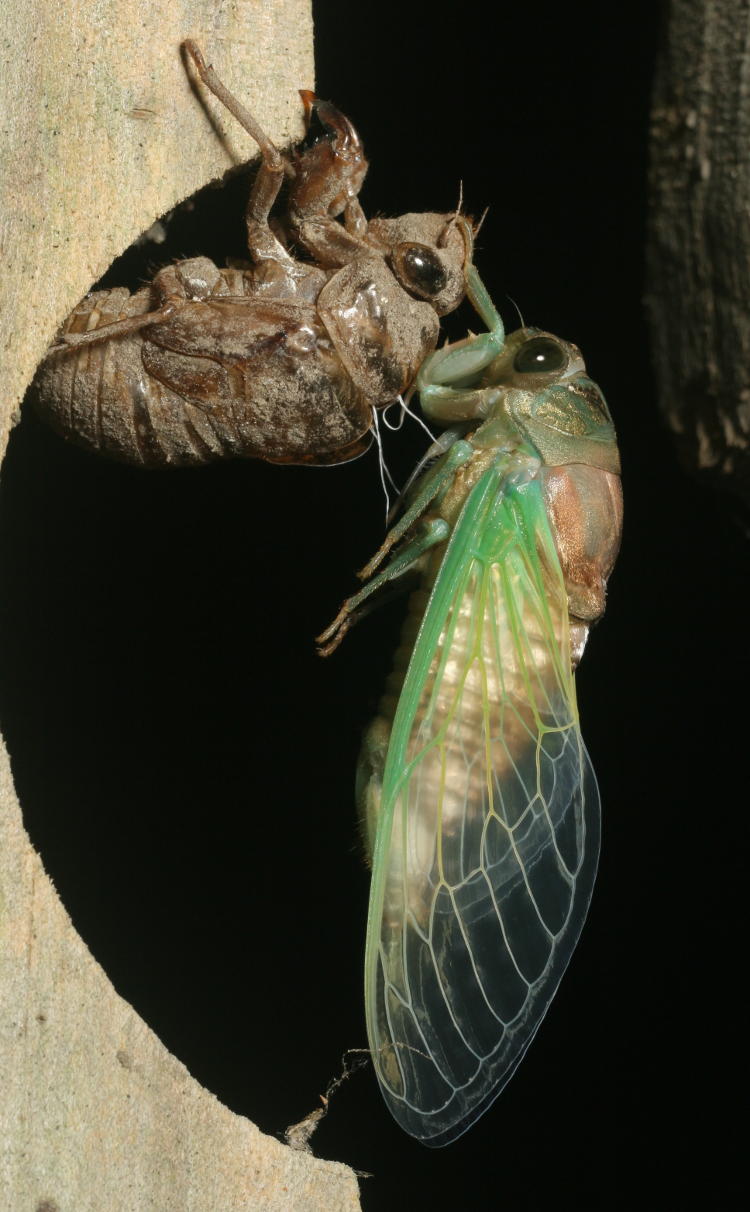
I was too late to see any action, but I’ll refer you to this post for more details – all I got was a few portraits posed on its former exoskeleton. I’m not going to try to identify this one, other than to say it’s a cicada, drying out after molting into its final instar, reproducing-adult form. And see those little white threads between the two? Those are its old lungs (seriously, check out that link.) And yes, that big green fellow just came out of the smaller brown dude, which is really just a empty husk – if you look close, you can see the undeveloped wings sitting over the second and third pairs of legs. Within an hour or so they transform between those two sizes. One day I’ll have a time-lapse sequence (because a video would be immensely boring.)
Another interlude before we get back to the mantids.
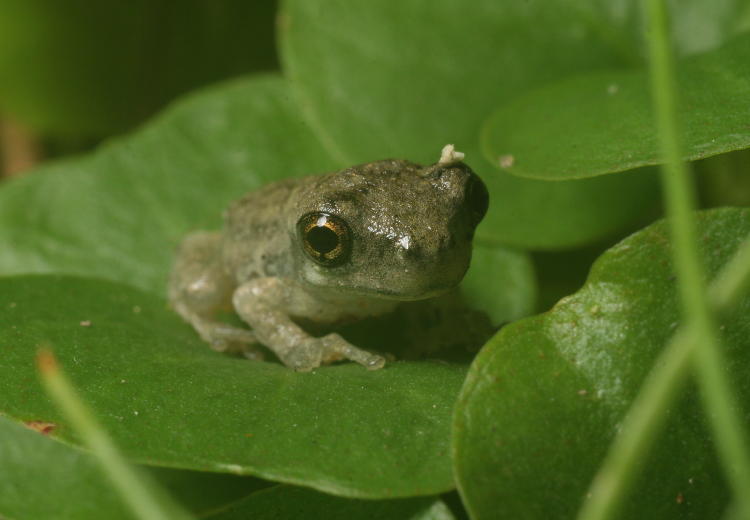 At this point, I’m going to go with more confidence in this being a juvenile Copes grey treefrog (Hyla chrysoscelis) without fully committing to that. It’s perched on the leaves of a creeping jenny plant, so if you know what those are like, you’ll get some idea of scale. Or look at the nail on your pinky, because that’s about the size of this frog. I misted a couple of these guys as well, but it makes them a little antsy, and doesn’t show off anything; the nature of their skin means the moisture simply slicks down and makes them shinier rather than beading up like on the arthropods. But yeah, I’m still watching where I walk carefully, only slightly reassured by the fact that these guys don’t sit on the ground much, but climb onto leaves and plants higher than feet tend to be.
At this point, I’m going to go with more confidence in this being a juvenile Copes grey treefrog (Hyla chrysoscelis) without fully committing to that. It’s perched on the leaves of a creeping jenny plant, so if you know what those are like, you’ll get some idea of scale. Or look at the nail on your pinky, because that’s about the size of this frog. I misted a couple of these guys as well, but it makes them a little antsy, and doesn’t show off anything; the nature of their skin means the moisture simply slicks down and makes them shinier rather than beading up like on the arthropods. But yeah, I’m still watching where I walk carefully, only slightly reassured by the fact that these guys don’t sit on the ground much, but climb onto leaves and plants higher than feet tend to be.
Okay, more misting fun from last night.

Once again, we’re in the same region of the yard, so it’s entirely possible that every photo of a Chinese mantis so far has been the same specimen. To say that this one was enthusiastic about the misting is understating the case; it was exuberantly slurping up whatever it could, completely ignoring me as I leaned in close with the macro rig and its focusing light. It’s this kind of display that makes me feel guilty when I’m not out there providing a drink (like, right now.) But while we’re here, note the row of little black spots on the thorax, straight down from the neck: those are its tracheoles, the air holes for respiration.
Another illustration:
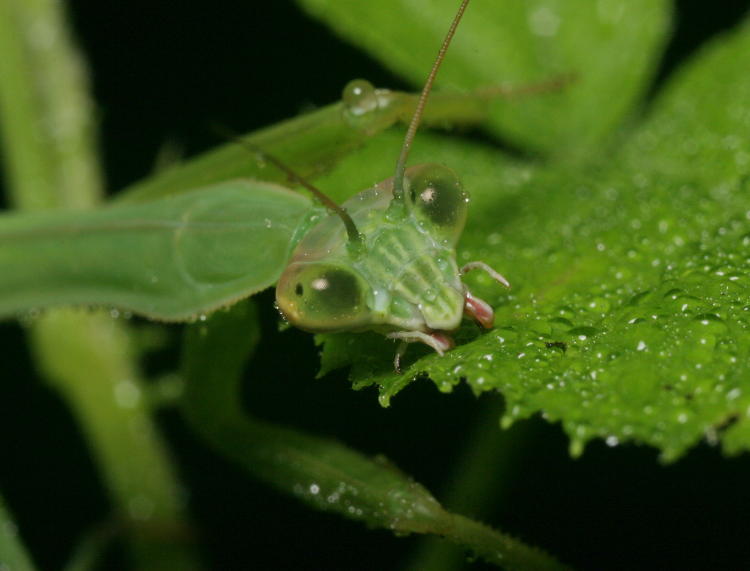
I know, those kinda look like tongues, but I don’t think mantids really have an equivalent. As I understand it, they have tasting organs on the forelegs anyway, to know what they’re grasping (which helps explain why they often don’t stay long if I manage to get one on my hands, which do get washed, every week or so.)
Another item of interest. I’m fairly certain this one was old enough/large enough to have the eyes turning black at night, and it was more than late enough for this to happen. But when I’ve observed the eyes not changing, it seemed to indicate an impending molt. I wasn’t even thinking about this last night until I’d unloaded the memory card, and should probably go out into that area and see if I can find an exoskeleton. Just to annoy me that I missed it again.
Moving around to the front yard now, same evening, I misted the mantis that’s been living there, and spotted another little froglet, who as I watched moved over and perched coyly on a day lily bloom. Well, okay then.
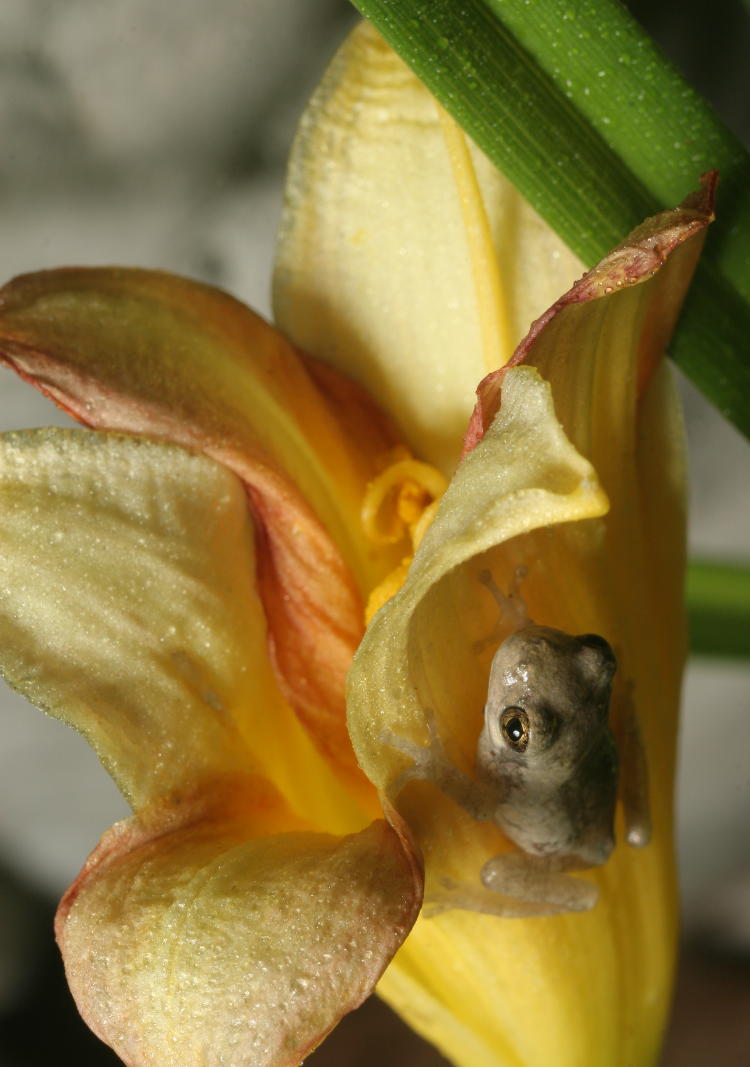
Now, this one posed all on its own, no help from me at all save the influence that the bobbing headlamp might have provided, but the same cannot be said for the next subject. On one of our potted plants nearby, I found a juvenile katydid, and they’re responsible for more than a little leaf damage to enough of our plants, so I snagged it and managed to successfully transfer it over to the rose plant where sat one of the mantises. Then, I waited, as the batteries in the headlamp grew weaker.
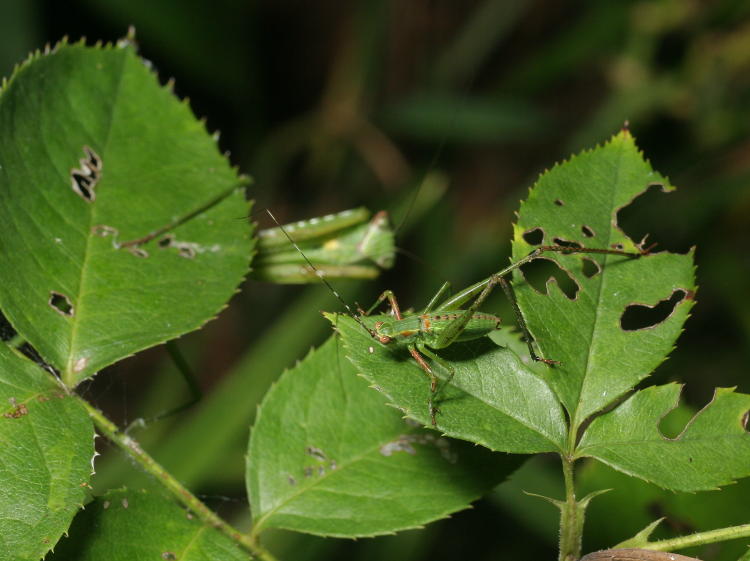
In case you missed it, that’s the mantis in the background. It took a few minutes before I was sure that it had noticed the katydid, and then quite a few more as the mantis glacially shifted position to prepare itself for the strike – believe me, this is one of the faster things that can be witnessed in nature photography, and it sill takes a lot of patience. It was, in fact, over fifteen minutes between my first and last photos, mostly spent standing still and watching, though I did shift position for a better vantage of the impending denouement. And, of course, the ‘stalking’ (really, shifting only a few millimeters) is painfully slow while the strike itself is so fast that even a sequence of photos won’t show much – with extreme timing and luck, one frame might capture the action itself – but, when is it going to take place? There’s no warning, no behavior that says, “Start firing off frames,” so you’re left with trying to trip the shutter in the milliseconds after you see sudden movement (and of course holding the camera in exact position all that time,) or simply waiting like I did to capture the aftermath. Or in this case, not bothering, because despite my presentation of an easy target, the mantis missed anyway, and the katydid hopped away. However, it couldn’t go far, so there remains the possibility that it did, or will, still provide a meal a little later on.
We’ll get a little fartsy for the last two images, again using the misting bottle, but this time to add a bit of ‘atmosphere.’ Or something.
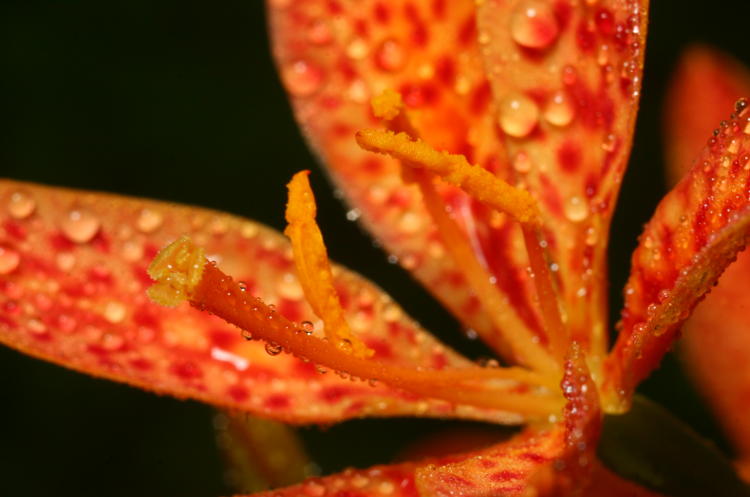
You don’t have to tell anyone this isn’t authentic dew if you do this – that’s up to you. If it bothers you, you can always get up early in the right conditions, and hope a real dew occurs while the flowers are still fresh; given the weather conditions recently, that wasn’t likely to happen here. But as tampering goes, I think everyone will find this pretty insignificant.
And one converted to monochrome. This is, by the way, a little more involved in GIMP than it is in Photoshop, unfortunately. Don’t know why there has to be such a difference.





















































